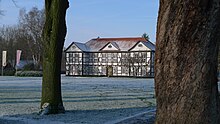Seesen Municipal Museum
The Städtisches Museum Seesen is a municipal museum in the Lower Saxony city of Seesen .
The museum building
The building erected at the beginning of the 18th century was originally a saddle yard , was converted into a hunting lodge in 1757 , and after the ducal household was dissolved in 1790, the forest authorities moved into it. In 1928 the building received its characteristic front with exposed framework. In 1959, the state forest authority sold the building to the city of Seesen, which initially rented the house as apartments. In 1964 it was opened as a local museum .
At the end of November 2010 the house was reopened with a new exhibition concept after almost a year of extensive renovation work.
Despite its proximity to the center, the building is charmingly embedded in a park with a pond behind it.
The exhibition
In addition to evidence of urban development and the earlier importance of the city as a regional railway junction , the exhibition primarily includes the history of the Steinweg / Steinway family of piano makers from the Harz Mountains ( Heinrich Steinweg , the founder of Steinway & Sons and his son Theodor Steinweg ) and the composer's work Louis Spohr in the city, an extensive mineral collection as well as the history of the local Jewish school from 1801, which is still active today thanks to the reform movement of its founder Israel Jacobson .
A model of the Seesen synagogue, which was destroyed by the National Socialists in 1938 during the Reichspogromnacht, can be seen in the exhibition rooms .
The so-called Jacob's temple from 1810 was the first synagogue that was planned exclusively for church services. The introduction of an organ was unusual in its day. With this concept, similar to the Protestant church building, the Seesen synagogue was the model for many Jewish sacred buildings built in the 19th century. Furthermore, the tin can production introduced in Seesen by Heinrich Züchner in Germany in 1830 is presented. A production line from 1950 also shows the step from one-off production to affordable mass-produced goods.
literature
- Karl Steinacker : The architectural and art monuments of the Duchy of Braunschweig , Volume 5, Gandersheim district, 1910
Web links
Coordinates: 51 ° 53 ′ 33.5 ″ N , 10 ° 10 ′ 19.1 ″ E

